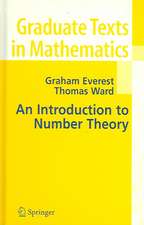Elementary Number Theory: Springer Undergraduate Mathematics Series
Autor Gareth A. Jones, Josephine M. Jonesen Limba Engleză Paperback – 14 ian 1998
Din seria Springer Undergraduate Mathematics Series
-
 Preț: 319.90 lei
Preț: 319.90 lei -
 Preț: 237.41 lei
Preț: 237.41 lei -
 Preț: 319.02 lei
Preț: 319.02 lei -
 Preț: 325.20 lei
Preț: 325.20 lei -
 Preț: 238.28 lei
Preț: 238.28 lei -
 Preț: 237.29 lei
Preț: 237.29 lei -
 Preț: 265.92 lei
Preț: 265.92 lei -
 Preț: 236.87 lei
Preț: 236.87 lei -
 Preț: 236.97 lei
Preț: 236.97 lei -
 Preț: 240.63 lei
Preț: 240.63 lei -
 Preț: 237.18 lei
Preț: 237.18 lei -
 Preț: 283.11 lei
Preț: 283.11 lei -
 Preț: 359.15 lei
Preț: 359.15 lei -
 Preț: 358.55 lei
Preț: 358.55 lei -
 Preț: 224.54 lei
Preț: 224.54 lei -
 Preț: 358.82 lei
Preț: 358.82 lei -
 Preț: 301.10 lei
Preț: 301.10 lei -
 Preț: 383.17 lei
Preț: 383.17 lei -
 Preț: 229.86 lei
Preț: 229.86 lei -
 Preț: 268.37 lei
Preț: 268.37 lei -
 Preț: 166.75 lei
Preț: 166.75 lei -
 Preț: 239.86 lei
Preț: 239.86 lei -
 Preț: 266.70 lei
Preț: 266.70 lei -
 Preț: 269.99 lei
Preț: 269.99 lei - 15%
 Preț: 526.67 lei
Preț: 526.67 lei -
 Preț: 320.20 lei
Preț: 320.20 lei -
 Preț: 272.49 lei
Preț: 272.49 lei -
 Preț: 272.69 lei
Preț: 272.69 lei -
 Preț: 258.88 lei
Preț: 258.88 lei -
 Preț: 265.83 lei
Preț: 265.83 lei -
 Preț: 265.18 lei
Preț: 265.18 lei -
 Preț: 275.36 lei
Preț: 275.36 lei -
 Preț: 278.24 lei
Preț: 278.24 lei -
 Preț: 266.70 lei
Preț: 266.70 lei -
 Preț: 275.74 lei
Preț: 275.74 lei -
 Preț: 328.08 lei
Preț: 328.08 lei -
 Preț: 265.78 lei
Preț: 265.78 lei -
 Preț: 275.74 lei
Preț: 275.74 lei -
 Preț: 273.45 lei
Preț: 273.45 lei -
 Preț: 277.32 lei
Preț: 277.32 lei -
 Preț: 270.57 lei
Preț: 270.57 lei -
 Preț: 273.63 lei
Preț: 273.63 lei -
 Preț: 270.19 lei
Preț: 270.19 lei -
 Preț: 265.36 lei
Preț: 265.36 lei -
 Preț: 265.36 lei
Preț: 265.36 lei -
 Preț: 268.08 lei
Preț: 268.08 lei -
 Preț: 272.86 lei
Preț: 272.86 lei -
 Preț: 272.69 lei
Preț: 272.69 lei -
 Preț: 271.16 lei
Preț: 271.16 lei
Preț: 221.92 lei
Nou
Puncte Express: 333
Preț estimativ în valută:
42.48€ • 46.16$ • 35.70£
42.48€ • 46.16$ • 35.70£
Carte disponibilă
Livrare economică 31 martie-14 aprilie
Livrare express 14-20 martie pentru 30.34 lei
Preluare comenzi: 021 569.72.76
Specificații
ISBN-13: 9783540761976
ISBN-10: 3540761977
Pagini: 316
Ilustrații: XIV, 302 p.
Dimensiuni: 178 x 235 x 17 mm
Greutate: 0.46 kg
Ediția:1998
Editura: SPRINGER LONDON
Colecția Springer
Seria Springer Undergraduate Mathematics Series
Locul publicării:London, United Kingdom
ISBN-10: 3540761977
Pagini: 316
Ilustrații: XIV, 302 p.
Dimensiuni: 178 x 235 x 17 mm
Greutate: 0.46 kg
Ediția:1998
Editura: SPRINGER LONDON
Colecția Springer
Seria Springer Undergraduate Mathematics Series
Locul publicării:London, United Kingdom
Public țintă
Lower undergraduateCuprins
1. Divisibility.- 1.1 Divisors.- 1.2 Bezout’s identity.- 1.3 Least common multiples.- 1.4 Linear Diophantine equations.- 1.5 Supplementary exercises.- 2. Prime Numbers.- 2.1 Prime numbers and prime-power factorisations.- 2.2 Distribution of primes.- 2.3 Fermat and Mersenne primes.- 2.4 Primality-testing and factorisation.- 2.5 Supplementary exercises.- 3. Congruences.- 3.1 Modular arithmetic.- 3.2 Linear congruences.- 3.3 Simultaneous linear congruences.- 3.4 Simultaneous non-linear congruences.- 3.5 An extension of the Chinese Remainder Theorem.- 3.6 Supplementary exercises.- 4. Congruences with a Prime-power Modulus.- 4.1 The arithmetic of ?p.- 4.2 Pseudoprimes and Carmichael numbers.- 4.3 Solving congruences mod (pe).- 4.4 Supplementary exercises.- 5. Euler’s Function.- 5.1 Units.- 5.2 Euler’s function.- 5.3 Applications of Euler’s function.- 5.4 Supplementary exercises.- 6. The Group of Units.- 6.1 The group Un.- 6.2 Primitive roots.- 6.3 The group Une, where p is an odd prime.- 6.4 The group U2e.- 6.5 The existence of primitive roots.- 6.6 Applications of primitive roots.- 6.7 The algebraic structure of Un.- 6.8 The universal exponent.- 6.9 Supplementary exercises.- 7. Quadratic Residues.- 7.1 Quadratic congruences.- 7.2 The group of quadratic residues.- 7.3 The Legendre symbol.- 7.4 Quadratic reciprocity.- 7.5 Quadratic residues for prime-power moduli.- 7.6 Quadratic residues for arbitrary moduli.- 7.7 Supplementary exercises.- 8. Arithmetic Functions.- 8.1 Definition and examples.- 8.2 Perfect numbers.- 8.3 The Mobius Inversion Formula.- 8.4 An application of the Mobius Inversion Formula.- 8.5 Properties of the Mobius function.- 8.6 The Dirichlet product.- 8.7 Supplementary exercises.- 9. The Riemann Zeta Function.- 9.1 Historical background.- 9.2 Convergence.- 9.3 Applications to prime numbers.- 9.4 Random integers.- 9.5 Evaluating ?(2).- 9.6 Evaluating ?(2k).- 9.7 Dirichlet series.- 9.8 Euler products.- 9.9 Complex variables.- 9.10 Supplementary exercises.-10. Sums of Squares.- 10.1 Sums of two squares.- 10.2 The Gaussian integers.- 10.3 Sums of three squares.- 10.4 Sums of four squares.- 10.5 Digression on quaternions.- 10.6 Minkowski’s Theorem.- 10.7 Supplementary exercises.- 11. Fermat’s Last Theorem.- 11.1 The problem.- 11.2 Pythagoras’s Theorem.- 11.3 Pythagorean triples.- 11.4 Isosceles triangles and irrationality.- 11.5 The classification of Pythagorean triples.- 11.6 Fermat.- 11.7 The case n = 4.- 11.8 Odd prime exponents.- 11.9 Lame and Kummer.- 11.10 Modern developments.- 11.11 Further reading.- Solutions to Exercises.- Index of symbols.- Index of names.
Recenzii
From the reviews:
BULLETIN OF MATHEMATICS BOOKS
"?as a nice concluding chapter on Fermat? Last Theorem, with a brief discussion on the coup de grace."
G.A. Jones and J.M. Jones
Elementary Number Theory
"A welcome addition . . . a carefully and well-written book."—THE MATHEMATICAL GAZETTE
"This book would make an excellent text for an undergraduate course on number theory."
—MATHEMATICAL REVIEWS
BULLETIN OF MATHEMATICS BOOKS
"?as a nice concluding chapter on Fermat? Last Theorem, with a brief discussion on the coup de grace."
G.A. Jones and J.M. Jones
Elementary Number Theory
"A welcome addition . . . a carefully and well-written book."—THE MATHEMATICAL GAZETTE
"This book would make an excellent text for an undergraduate course on number theory."
—MATHEMATICAL REVIEWS
Caracteristici
The essential guide to number theory for undergraduates Distinguishing features include discussions of the Riemann Zeta Function and Riemann Hypothesis Includes supplementary material: sn.pub/extras


















